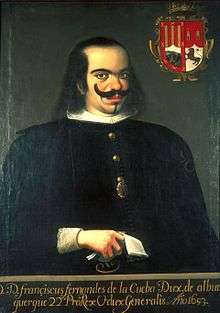Francisco Fernández de la Cueva, 8th Duke of Alburquerque
| Don Francisco Fernández de la Cueva 8th Duke of Alburquerque Caballero de Santiago | |
|---|---|
 | |
| Viceroy of Sicily | |
|
In office 1668–1670 | |
| Monarch | Philip IV |
| Preceded by | Francesco Caetani |
| Succeeded by | Claude Lamoral, Prince of Ligne |
| Viceroy of New Spain | |
|
In office August 15, 1653 – September 15, 1660 | |
| Monarch | Philip IV |
| Preceded by | Luis Enríquez de Guzmán, conde de Alba de Liste |
| Succeeded by | Juan de Leyva de la Cerda, conde de Baños |
| Personal details | |
| Born |
c.1619 Barcelona, Spain |
| Died |
March 27, 1676 (aged 56–57) Madrid, Spain |
| Spouse(s) | Juana de Armendáriz |
Don Francisco Fernández de la Cueva y Enriquez de Cabrera, 8th Duke of Alburquerque, Marquis of Cuéllar, Count of Ledesma and of Huelma, Grandee of Spain (1619 – March 27, 1676) was a Spanish military officer and viceroy of New Spain from August 15, 1653 to September 15, 1660. He was also viceroy of Sicily from 1668 to 1670.
Early life
Don Francisco Fernández de la Cueva was born at Barcelona into one of the most aristocratic families of Spain, as the eldest viable adult male from the third marriage of his father, the 7th duke, (1575–1637). His father was "one of the toughest, most rigorous, and successful of the viceroys of Catalonia...and had specialized in hte [sic] suppression of disorder."[1] Don Francisco's first marriage to Doña Antonia, a powerful "de Toledo-Beaumont" family woman, was childless. Further, the only offspring of the duke's marriage with Ana María de Padilla, his second wife, deceased before 1614, also from a powerful family, Beltran, died at age 16 before 1617. In his 3rd marriage, the heirless duke, married to a woman surnamed Enríquez de Cabrera y Colonna, who produced 10 children; his wife survived him some 21 years.
Francisco, the eldest male, entered military service when very young. He served in the cavalry [2] in Flanders. Later, as general of cavalry, he fought in the defense of Tortosa and in the siege of Barcelona in 1650. One feature of his career would be also his Ambassadorial activities in the Germanic countries.
Viceroy of New Spain
He made his formal entry into Mexico City to take up the reins of government on August 15, 1653. He was accompanied by his wife, Juana de Armendáriz, the daughter of Lope Díez de Armendáriz, a previous viceroy of New Spain.
Because of the war with England, he feared an invasion of Spanish territories in the New World. Because of this he strengthened the defenses of Veracruz and San Juan de Ulúa on the east coast of New Spain. He also sent arms and munitions to Jamaica, Cuba and Florida.
He increased trade with the Philippines, Siam and Cochinchina, sending mercury, saltpeter and other mineral products. He ordered the resumption of the minting of gold coins (suspended by Viceroy Antonio de Mendoza). He collected the royal rents with care, and sent back to Spain large quantities of silver. He reinforced the Armada de Barlovento, which guarded the coast and shipping. He ordered the construction in Campeche of new ships for the coastal and overseas trade. He also repaired the aqueduct supplying Mexico City with water.
The viceroy accelerated the construction of the new cathedral of Mexico City, visiting it every afternoon, climbing the scaffolding, and giving monetary rewards to the workers. During a visit to the cathedral on 12 March 1660, a 19-year-old soldier in the viceroy's guard, Manuel Ledesma y Robles of Madrid, attacked the viceroy with a sword. The viceroy survived. Justice was swift for his attacker, who was quickly tried, then dragged around the city and back to the Plaza Mayor, where he was hanged the next day.
The city of Alburquerque (now spelled Albuquerque), in what is now New Mexico, was founded on February 7, 1706 (not 1660) under his son's direction. He granted land to more than 100 Spanish families there.
The writers of this period attributed to his government a strong encouragement for the development of the sciences and the arts. His palace was considered a model of elegance and good taste.
Later life
He left New Spain for Madrid in September, 1660. Thereafter he was named lieutenant general of marines. He also served as ambassador extraordinary to Vienna to accompany Infanta Margaret Theresa of Spain, daughter of King Philip IV of Spain, when she married her uncle, Leopold I, Holy Roman Emperor. In 1668 Fernández de la Cueva was named viceroy of Sicily, where he remained two years. In 1674 the King appointed him as his Mayordomo mayor, chief of his Household.
He died in March, 1676 in the Royal Palace of Madrid.
References
- http://www.cabq.gov/museum/history/foundingabq.html
- (in Spanish) "Fernández de la Cueva, Francisco," Enciclopedia de México, v. 5. Mexico City, 1988.
- (in Spanish) García Puron, Manuel, México y sus gobernantes, v. 1. Mexico City: Joaquín Porrua, 1984.
- (in Spanish) Orozco Linares, Fernando, Gobernantes de México. Mexico City: Panorama Editorial, 1985, ISBN 968-38-0260-5.
| Government offices | ||
|---|---|---|
| Preceded by Francesco Caetani |
Viceroy of Sicily 1668-1670 |
Succeeded by The Prince of Ligne |
| Preceded by Luis Enríquez de Guzmán, conde de Alba de Liste |
Viceroy of New Spain 1653-1660 |
Succeeded by Juan de Leyva de la Cerda, conde de Baños |
| Spanish nobility | ||
| Preceded by Francisco Fernández de La Cueva, 7th Duke of Alburquerque |
Duke of Alburquerque 1637 - 1676 |
Succeeded by Melchor Fernández de La Cueva, 9th Duke of Alburquerque |

